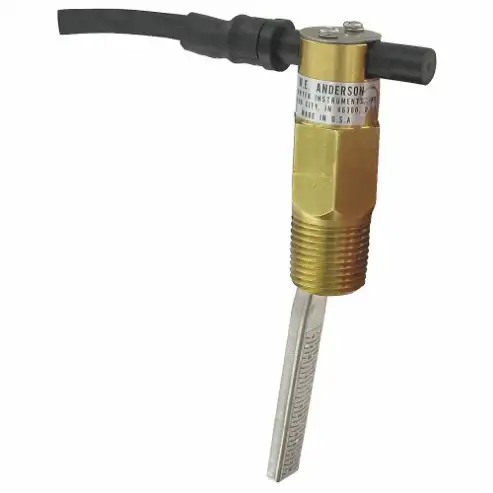Dwyer Instruments V10 Flotect flow switch is designed for use with motors, pumps, boilers, chillers and water heaters to control & monitor the flow of air, steam or liquid. It automatically starts or stops auxiliary pumps & engines to protect motors and other equipment against low or no flow.
Working Mechanism:
- A free-floating magnetic piston in a flow switch reacts to the flow rate in a pipe.
- Movement of the piston activates a hermetically sealed reed switch, which in turn causes the required action to be taken when the flow rate increases or decreases.
Features:
- This Dwyer V10 Flotect flow switch features brass construction for corrosion resistance and durability.
- The hermetically sealed reed switch features magnetically actuated switching mechanism and the field-trimmable, full-size vane offers user convenience.
- This mini-size unit allows a simple field switch adjustment facility for easy toggle between normally closed and normally open configurations without changing the electrical connections.
- It has an external switch housing for easy switch changeover and maintenance without interrupting the process flow.
- The model meets NEMA 4X IP66 enclosure rating for waterproof performance.
Standards and Approvals:
Frequently Asked Questions:
Q. Can the V10 flow switch be mounted for use in a vertical up-flow application?
A. Yes, the vane on the standard V10 features a spring return that enables attachment in any orientation.
Q. What do actuation and de-actuation mean?
A. Actuation refers to the phenomena when microswitch trips or the contacts of a microswitch change their state. De-actuation occurs when the flow rate is low enough for the microswitch to revert to its default setting.
Q. How to install this Dwyer flow switch?
A.
- Make sure you carefully unpack the switch and take any packaging out of the lower housing.
- The vane should be trimmed at the proper mark depending on the pipe size being utilised.
- Install the switch in the system piping with the arrow on the side pointing in the direction of flow and then apply pipe thread sealant to the 1/2 inch male NPT mounting threads.
- Install wiring in accordance with regional electrical regulations.
- When assessing system loads and currents, use caution.
- After installation, set the switch action to NO (usually open) or NC (normally closed).
- When a reed switch is activated by an increase in flow, usually closed connections open and normally open contacts close.
- The two screws on the top cap must be loosened but not removed in order to replace them.
- To reveal the specified switch action, slide the reed switch assembly.
- When the adjustment is finished, tighten the screws.
Q. What is the difference between inductive, capacitive and lamp load current ratings?
A.
- An inductive load is due to an electromagnetic solenoid, electromagnetic relay and electromagnetic counter with an inductive component as a circuit load.
- A capacitive load is a capacitor connected in series or parallel with reed switch control. In a closed circuit, a cable length, generally greater than 50 metres, is used to connect the reed switch which may also evolve static capacitance.
- A lamp load can occur because of a tungsten filament lamp load.
 Change Country
Change Country
